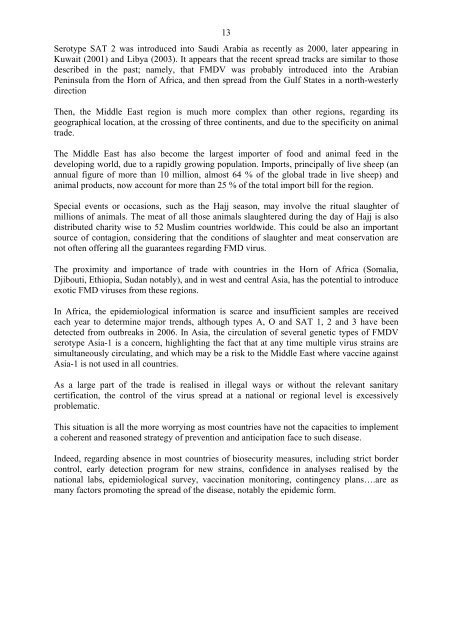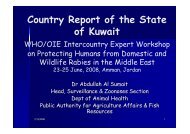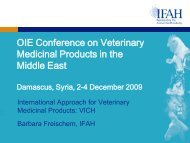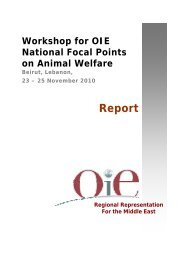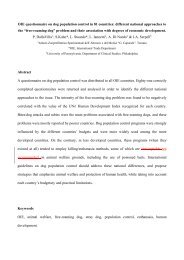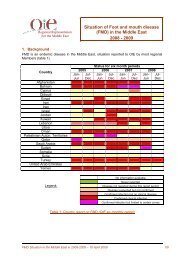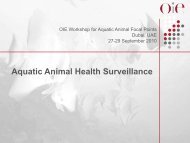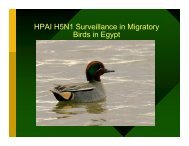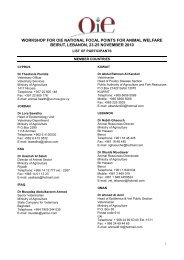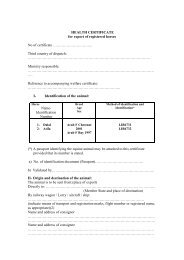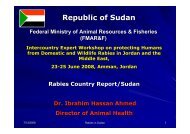12• Only a few countries <strong>in</strong> <strong>the</strong> region have developed <strong>and</strong> formalised <strong>the</strong>ir cont<strong>in</strong>gencyplann<strong>in</strong>g aga<strong>in</strong>st <strong>FMD</strong>;• With few exceptions, vacc<strong>in</strong>ation strategy is ei<strong>the</strong>r poorly planned or entirely lack<strong>in</strong>g<strong>in</strong> most of countries;• Most of <strong>the</strong> vacc<strong>in</strong>e serotypes used <strong>in</strong> <strong>the</strong> region are not match<strong>in</strong>g with <strong>the</strong> localserotypes;• Live animals <strong>and</strong> animal products are largely imported from regions <strong>and</strong> countries thathave been practic<strong>in</strong>g vacc<strong>in</strong>ation aga<strong>in</strong>st <strong>the</strong> disease, with<strong>in</strong> <strong>the</strong> entire country or partsof it or <strong>FMD</strong> free with vacc<strong>in</strong>ation with no previous assessment of <strong>the</strong> vacc<strong>in</strong>ationprograms <strong>in</strong> <strong>the</strong> export<strong>in</strong>g countries <strong>and</strong>/or <strong>the</strong>ir national surveillance plans.• No country <strong>in</strong> <strong>the</strong> region currently ma<strong>in</strong>ta<strong>in</strong>s an antigen bank;• The diagnosis facilities for <strong>FMD</strong> are not well developed, thus, <strong>in</strong> 2005-2006, <strong>the</strong>rehave been serious delays <strong>in</strong> diagnosis of <strong>the</strong> new type A viruses because diagnostictests were not optimised for <strong>the</strong> type A <strong>in</strong>fections;• There is a need <strong>to</strong> build confidence <strong>in</strong> labora<strong>to</strong>ry capacity <strong>in</strong> <strong>the</strong> region for earlydetection of new stra<strong>in</strong>s, <strong>and</strong> for moni<strong>to</strong>r<strong>in</strong>g of vacc<strong>in</strong>ation programs <strong>and</strong> serosurveillance;• Most <strong>Middle</strong> <strong>East</strong>ern countries have a national reference labora<strong>to</strong>ry for <strong>FMD</strong>, but that<strong>the</strong>re is significant variation <strong>in</strong> capacity, <strong>in</strong> bio-safety, <strong>and</strong> <strong>in</strong> st<strong>and</strong>ardisation of <strong>FMD</strong>tests, lead<strong>in</strong>g <strong>to</strong> lack of confidence <strong>in</strong> labora<strong>to</strong>ry results, which affects trade prospects;• Many countries lack <strong>the</strong> experience <strong>in</strong> design of surveillance <strong>in</strong> potential export or<strong>FMD</strong> free zones, or follow<strong>in</strong>g <strong>FMD</strong> outbreaks;• Some countries, which are not meat exporter, don’t identify <strong>FMD</strong> control as a priorityfor <strong>the</strong>ir own country or don’t have sufficient <strong>and</strong> effective resources <strong>to</strong> be <strong>in</strong>volved <strong>in</strong>such control.5. Short term perspectives <strong>and</strong> risk transmission <strong>to</strong> neighbour<strong>in</strong>g regionsThe new serotype A virus (A Iran 2005) has cont<strong>in</strong>ued <strong>to</strong> spread <strong>in</strong> 2006, circulat<strong>in</strong>g <strong>in</strong>Turkey <strong>and</strong> Iran. The Egyptian new serotype A still affects this country, represent<strong>in</strong>g a threatfor <strong>the</strong> neighbour<strong>in</strong>g countries.The detection of <strong>the</strong> A-Iran-05 <strong>in</strong> Pakistan <strong>and</strong> Saudi Arabia <strong>in</strong> 2006 produces <strong>the</strong> proof.Fur<strong>the</strong>r spread of <strong>the</strong> A- Iran- 2005 <strong>and</strong> possibly A- Egypt- 2006 viruses <strong>to</strong> countries <strong>in</strong> <strong>the</strong>Near-<strong>East</strong> is likely <strong>to</strong> occur unless effective preventive measures are taken <strong>and</strong> so <strong>the</strong>iruncontrolled spread represents a high risk of transmission <strong>to</strong> neighbour<strong>in</strong>g countries.The presence of <strong>the</strong> A-Iran-2005 <strong>in</strong> Thrace, at <strong>the</strong> borders from Greece <strong>and</strong> Bulgaria, is alsoan important threat of virus <strong>in</strong>troduction <strong>in</strong><strong>to</strong> <strong>the</strong> European Union countries.In <strong>the</strong> past, exotic stra<strong>in</strong>s of <strong>FMD</strong> virus were <strong>in</strong>volved <strong>in</strong> panzootics, cover<strong>in</strong>g large areas <strong>in</strong><strong>the</strong> region, extend<strong>in</strong>g as far as <strong>the</strong> frontiers of Europe. Such panzootics <strong>in</strong>cluded outbreaks of<strong>FMD</strong>V types Asia 1 (1957-1964, 2000), SAT 1 (1962-1964), <strong>and</strong> A 22 (1964-1965, 1996). Therecurrence of such situations is not a remote possibility, due ma<strong>in</strong>ly <strong>to</strong> <strong>the</strong> cont<strong>in</strong>uous <strong>in</strong>fluxof live sheep for slaughter, pr<strong>in</strong>cipally <strong>in</strong><strong>to</strong> <strong>the</strong> Arabian Pen<strong>in</strong>sula. Animals from Africa <strong>and</strong>Asia can readily <strong>in</strong>troduce stra<strong>in</strong>s of <strong>FMD</strong>V which <strong>the</strong>n spread among <strong>the</strong> local rum<strong>in</strong>ants,particularly nomadic sheep <strong>and</strong> goats. These animals may <strong>the</strong>n fur<strong>the</strong>r dissem<strong>in</strong>ate <strong>the</strong> virus<strong>in</strong><strong>to</strong> large-scale, commercial dairy farms.
13Serotype SAT 2 was <strong>in</strong>troduced <strong>in</strong><strong>to</strong> Saudi Arabia as recently as 2000, later appear<strong>in</strong>g <strong>in</strong>Kuwait (2001) <strong>and</strong> Libya (2003). It appears that <strong>the</strong> recent spread tracks are similar <strong>to</strong> thosedescribed <strong>in</strong> <strong>the</strong> past; namely, that <strong>FMD</strong>V was probably <strong>in</strong>troduced <strong>in</strong><strong>to</strong> <strong>the</strong> ArabianPen<strong>in</strong>sula from <strong>the</strong> Horn of Africa, <strong>and</strong> <strong>the</strong>n spread from <strong>the</strong> Gulf States <strong>in</strong> a north-westerlydirectionThen, <strong>the</strong> <strong>Middle</strong> <strong>East</strong> region is much more complex than o<strong>the</strong>r regions, regard<strong>in</strong>g itsgeographical location, at <strong>the</strong> cross<strong>in</strong>g of three cont<strong>in</strong>ents, <strong>and</strong> due <strong>to</strong> <strong>the</strong> specificity on animaltrade.The <strong>Middle</strong> <strong>East</strong> has also become <strong>the</strong> largest importer of food <strong>and</strong> animal feed <strong>in</strong> <strong>the</strong>develop<strong>in</strong>g world, due <strong>to</strong> a rapidly grow<strong>in</strong>g population. Imports, pr<strong>in</strong>cipally of live sheep (anannual figure of more than 10 million, almost 64 % of <strong>the</strong> global trade <strong>in</strong> live sheep) <strong>and</strong>animal products, now account for more than 25 % of <strong>the</strong> <strong>to</strong>tal import bill for <strong>the</strong> region.Special events or occasions, such as <strong>the</strong> Hajj season, may <strong>in</strong>volve <strong>the</strong> ritual slaughter ofmillions of animals. The meat of all those animals slaughtered dur<strong>in</strong>g <strong>the</strong> day of Hajj is alsodistributed charity wise <strong>to</strong> 52 Muslim countries worldwide. This could be also an importantsource of contagion, consider<strong>in</strong>g that <strong>the</strong> conditions of slaughter <strong>and</strong> meat conservation arenot often offer<strong>in</strong>g all <strong>the</strong> guarantees regard<strong>in</strong>g <strong>FMD</strong> virus.The proximity <strong>and</strong> importance of trade with countries <strong>in</strong> <strong>the</strong> Horn of Africa (Somalia,Djibouti, Ethiopia, Sudan notably), <strong>and</strong> <strong>in</strong> west <strong>and</strong> central Asia, has <strong>the</strong> potential <strong>to</strong> <strong>in</strong>troduceexotic <strong>FMD</strong> viruses from <strong>the</strong>se regions.In Africa, <strong>the</strong> epidemiological <strong>in</strong>formation is scarce <strong>and</strong> <strong>in</strong>sufficient samples are receivedeach year <strong>to</strong> determ<strong>in</strong>e major trends, although types A, O <strong>and</strong> SAT 1, 2 <strong>and</strong> 3 have beendetected from outbreaks <strong>in</strong> 2006. In Asia, <strong>the</strong> circulation of several genetic types of <strong>FMD</strong>Vserotype Asia-1 is a concern, highlight<strong>in</strong>g <strong>the</strong> fact that at any time multiple virus stra<strong>in</strong>s aresimultaneously circulat<strong>in</strong>g, <strong>and</strong> which may be a risk <strong>to</strong> <strong>the</strong> <strong>Middle</strong> <strong>East</strong> where vacc<strong>in</strong>e aga<strong>in</strong>stAsia-1 is not used <strong>in</strong> all countries.As a large part of <strong>the</strong> trade is realised <strong>in</strong> illegal ways or without <strong>the</strong> relevant sanitarycertification, <strong>the</strong> control of <strong>the</strong> virus spread at a national or regional level is excessivelyproblematic.This situation is all <strong>the</strong> more worry<strong>in</strong>g as most countries have not <strong>the</strong> capacities <strong>to</strong> implementa coherent <strong>and</strong> reasoned strategy of prevention <strong>and</strong> anticipation face <strong>to</strong> such disease.Indeed, regard<strong>in</strong>g absence <strong>in</strong> most countries of biosecurity measures, <strong>in</strong>clud<strong>in</strong>g strict bordercontrol, early detection program for new stra<strong>in</strong>s, confidence <strong>in</strong> analyses realised by <strong>the</strong>national labs, epidemiological survey, vacc<strong>in</strong>ation moni<strong>to</strong>r<strong>in</strong>g, cont<strong>in</strong>gency plans….are asmany fac<strong>to</strong>rs promot<strong>in</strong>g <strong>the</strong> spread of <strong>the</strong> disease, notably <strong>the</strong> epidemic form.


